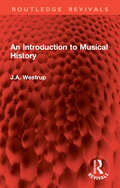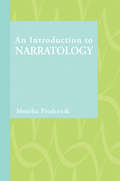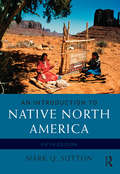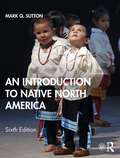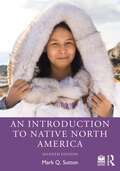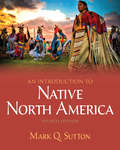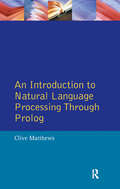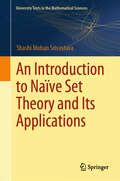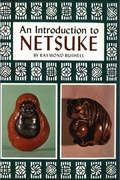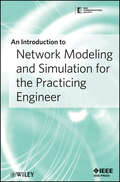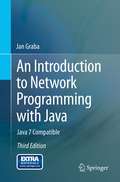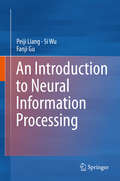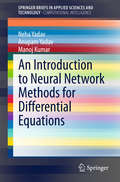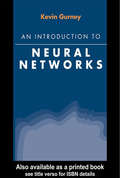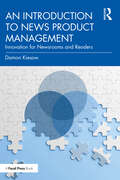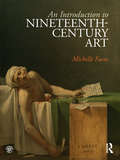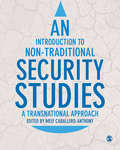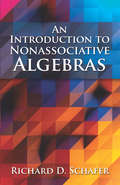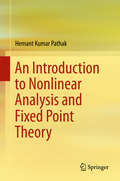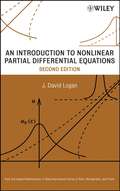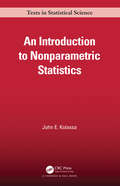- Table View
- List View
An Introduction to Musical History (Routledge Revivals)
by J.A. WestrupFirst published in 1955, An Introduction to Musical History is not just another short history of music, but a discussion of its sources and background. It explains how we derive our knowledge of the music of the past, and how music has been affected by its social and political background. Such topics as the influence of language and racial characteristics find their place here, as well as the contributions made by literature and painting. Some of the problems presented by musical history are examined, and an indication is given of the best method of studying it. This book will be an interesting read for students and researchers of music.
An Introduction to Narratology
by Monika FludernikAn Introduction to Narratology is an accessible, practical guide to narratological theory and terminology and its application to literature. In this book, Monika Fludernik outlines: the key concepts of style, metaphor and metonymy, and the history of narrative forms narratological approaches to interpretation and the linguistic aspects of texts, including new cognitive developments in the field how students can use narratological theory to work with texts, incorporating detailed practical examples a glossary of useful narrative terms, and suggestions for further reading. This textbook offers a comprehensive overview of the key aspects of narratology by a leading practitioner in the field. It demystifies the subject in a way that is accessible to beginners, but also reflects recent theoretical developments and narratology’s increasing popularity as a critical tool.
An Introduction to Native North America
by Mark Q. SuttonAn Introduction to Native North America provides a basic introduction to the Native Peoples of North America, covering what are now the United States, northern Mexico, and Canada. It covers the history of research, basic prehistory, the European invasion and the impact of Europeans on Native cultures. A final chapter covers contemporary Native Americans, including issues of religion, health, and politics. In this updated and revised new edition, Mark Q. Sutton has expanded and improved the existing text as well as adding a new case study, updated the text with new research, and included new perspectives, particularly those of Native peoples. Featuring case studies of several tribes, as well as over 60 maps and images, An Introduction to Native North America is an indispensable tool to those studying the history of North America and Native Peoples of North America. .
An Introduction to Native North America
by Mark Q. SuttonAn Introduction to Native North America provides a basic introduction to the Native peoples of North America, covering what are now the United States, northern Mexico, and Canada. In this updated and revised new edition, Mark Q. Sutton has expanded and improved the existing text, adding to the case studies, updating the text with the latest research, increasing the number of images, providing more coverage of the Arctic regions, and including new perspectives, particularly those of Native peoples. The book addresses the history of research, the European invasion, and the impact of Europeans on Native societies. A final chapter introduces contemporary Native Americans, discussing issues that affect them, including religion, health, and politics. The book retains a wealth of pedological features to aid and reinforce learning. Featuring case studies of many Native American groups, as well as some eighty-four maps and images, An Introduction to Native North America is an indispensable tool to those studying the history of North America and its Native peoples.
An Introduction to Native North America
by Mark Q. SuttonAn Introduction to Native North America provides a basic introduction to the Native peoples of North America, covering what are now the United States, northern Mexico, and Canada.In this updated and revised new edition, Mark Q. Sutton has expanded and improved the existing text, adding to the case studies, updating the text with the latest research, increasing the number of images, providing more coverage of the Arctic regions, and including new perspectives, particularly those of Native peoples. This book addresses the history of research, the European invasion, and the impact of Europeans on Native societies. A final chapter introduces contemporary Native Americans, discussing issues that affect them, including religion, health, and politics. The book retains a wealth of pedological features to aid and reinforce learning.Featuring case studies of many Native American groups, as well as some 87 maps and images, An Introduction to Native North America is an indispensable tool to those studying the history of North America and its Native peoples.
An Introduction to Native North America -- Pearson eText
by Mark Q. SuttonAn Introduction to Native North America provides a basic introduction to the native peoples of North America, including both the United States and Canada. It covers the history of research, basic prehistory, the European invasion and the impact of Europeans on Native cultures. Additionally, much of the book is written from the perspective of the ethnographic present, and the various cultures are described as they were at the specific times noted in the text. Teaching and Learning Experiences: Improve Critical Thinking - An Introduction to Native North America provides internet resources for students to supplement reading material, and contains an extensive bibliography to aid in their research. Engage Students - An Introduction to Native North America highlights important individuals in "VIP Profile" mini-biographies, and contains "Sidelights" throughout the text which provides short explanations of interesting aspects of native culture. Support Instructors - Teaching your course just got easier! You can create a Customized Text or use our Instructor's Manual, Electronic "MyTest" Test Bank or PowerPoint Presentation Slides. Plus, An Introduction to Native North America's organization was designed to be used in conjunction with the Handbook of North American Indians, published by the Smithsonian Institution.
An Introduction to Natural Language Processing Through Prolog (Learning about Language)
by Clive MatthewsResearch into Natural Language Processing - the use of computers to process language - has developed over the last couple of decades into one of the most vigorous and interesting areas of current work on language and communication. This book introduces the subject through the discussion and development of various computer programs which illustrate some of the basic concepts and techniques in the field. The programming language used is Prolog, which is especially well-suited for Natural Language Processing and those with little or no background in computing.Following the general introduction, the first section of the book presents Prolog, and the following chapters illustrate how various Natural Language Processing programs may be written using this programming language. Since it is assumed that the reader has no previous experience in programming, great care is taken to provide a simple yet comprehensive introduction to Prolog. Due to the 'user friendly' nature of Prolog, simple yet effective programs may be written from an early stage. The reader is gradually introduced to various techniques for syntactic processing, ranging from Finite State Network recognisors to Chart parsers. An integral element of the book is the comprehensive set of exercises included in each chapter as a means of cementing the reader's understanding of each topic. Suggested answers are also provided.An Introduction to Natural Language Processing Through Prolog is an excellent introduction to the subject for students of linguistics and computer science, and will be especially useful for those with no background in the subject.
An Introduction to Naïve Set Theory and Its Applications (University Texts in the Mathematical Sciences)
by Shashi Mohan SrivastavaPrimarily designed for graduate students of mathematics, this textbook delves into Naïve set theory, offering valuable insights for senior undergraduate students and researchers specializing in set theory. Commencing with a comprehensive exploration of functions and relations, the book extends its coverage to various applications of Naïve set theory across multiple mathematical branches, including real analysis, linear and abstract algebra, general topology, and introductory aspects of complex analysis and measure theory. The text meticulously introduces cardinal and ordinal numbers, along with transfinite induction, following the natural progression discovered by Cantor during his examination of trigonometric series. While this book provides a solid foundation, students intrigued by set theory for its intrinsic value should recognize that the subject extends far beyond the scope of this text.
An Introduction to Netsuke
by Raymond BushellWith dozens of photos and illustrations, A Introduction to Netsuke is a readable and thorough guide to Japanese miniature art.Among the many Japanese fine arts, few have aroused greater admiration than the netsuke. This miniature piece of Japanese sculpture, approximately 1 1/2 inches in size, was designed (in the absence of pockets on kimonos) as an aid in suspending articles such as tobacco pouches from the sash of a kimono. It developed in ancient times as a utilitarian object, but became in the 16th century an artistic one as well, and flourished as such until 1926. No longer commonly worn, the netsuke is now a collectors' item, avidly sought throughout the world by those sensitive to its fine qualities.This book opens the miniature world of netsuke to those who have hitherto been unaware of its existence. In a delightfully lucid manner, the basics of the netsuke are presented-definition, origin, development, materials, statistics, and photographs. This book admirably fulfills its task of introducing the netsuke to the layman, irresistibly drawing him to new pleasures in aestheticism and culture.
An Introduction to Network Modeling and Simulation for the Practicing Engineer (The ComSoc Guides to Communications Technologies #5)
by Jon Ward Jack L. Burbank William KaschThis book provides the practicing engineer with a concise listing of commercial and open-source modeling and simulation tools currently available including examples of implementing those tools for solving specific Modeling and Simulation examples. Instead of focusing on the underlying theory of Modeling and Simulation and fundamental building blocks for custom simulations, this book compares platforms used in practice, and gives rules enabling the practicing engineer to utilize available Modeling and Simulation tools. This book will contain insights regarding common pitfalls in network Modeling and Simulation and practical methods for working engineers.
An Introduction to Network Programming with Java: Java 7 Compatible
by Jan GrabaSince the second edition of this text, the use of the Internet and networks generally has continued to expand at a phenomenal rate. This has led to both an increase in demand for network software and to improvements in the technology used to run such networks, with the latter naturally leading to changes in the former. During this time, the Java libraries have been updated to keep up with the new developments in network technology, so that the Java programming language continues to be one of the mainstays of network software development. In providing a very readable text that avoids getting immersed in low-level technical details, while still providing a useful, practical guide to network programming for both undergraduates and busy IT professionals, this third edition continues the trend of its predecessors. To retain its currency, the text has been updated to reflect changes that have taken place in Java's network technology over the past seven years (including the release of Java 7), whilst retaining its notable features of numerous code examples, screenshots and end-of-chapter exercises.
An Introduction to Neural Information Processing
by Fanji Gu Peiji Liang Si WuThis book provides an overview of neural information processing research, which is one of the most important branches of neuroscience today. Neural information processing is an interdisciplinary subject, and the merging interaction between neuroscience and mathematics, physics, as well as information science plays a key role in the development of this field. This book begins with the anatomy of the central nervous system, followed by an introduction to various information processing models at different levels. The authors all have extensive experience in mathematics, physics and biomedical engineering, and have worked in this multidisciplinary area for a number of years. They present classical examples of how the pioneers in this field used theoretical analysis, mathematical modeling and computer simulation to solve neurobiological problems, and share their experiences and lessons learned. The book is intended for researchers and students with a mathematics, physics or informatics background who are interested in brain research and keen to understand the necessary neurobiology and how they can use their specialties to address neurobiological problems. It is also provides inspiration for neuroscience students who are interested in learning how to use mathematics, physics or informatics approaches to solve problems in their field.
An Introduction to Neural Network Methods for Differential Equations (SpringerBriefs in Applied Sciences and Technology)
by Manoj Kumar Neha Yadav Anupam YadavThis book introduces a variety of neural network methods for solving differential equations arising in science and engineering. The emphasis is placed on a deep understanding of the neural network techniques, which has been presented in a mostly heuristic and intuitive manner. This approach will enable the reader to understand the working, efficiency and shortcomings of each neural network technique for solving differential equations. The objective of this book is to provide the reader with a sound understanding of the foundations of neural networks and a comprehensive introduction to neural network methods for solving differential equations together with recent developments in the techniques and their applications. The book comprises four major sections. Section I consists of a brief overview of differential equations and the relevant physical problems arising in science and engineering. Section II illustrates the history of neural networks starting from their beginnings in the 1940s through to the renewed interest of the 1980s. A general introduction to neural networks and learning technologies is presented in Section III. This section also includes the description of the multilayer perceptron and its learning methods. In Section IV, the different neural network methods for solving differential equations are introduced, including discussion of the most recent developments in the field. Advanced students and researchers in mathematics, computer science and various disciplines in science and engineering will find this book a valuable reference source.
An Introduction to Neural Networks
by Kevin GurneyThough mathematical ideas underpin the study of neural networks, the author presents the fundamentals without the full mathematical apparatus. All aspects of the field are tackled, including artificial neurons as models of their real counterparts; the geometry of network action in pattern space; gradient descent methods, including back-propagation; associative memory and Hopfield nets; and self-organization and feature maps. The traditionally difficult topic of adaptive resonance theory is clarified within a hierarchical description of its operation. The book also includes several real-world examples to provide a concrete focus. This should enhance its appeal to those involved in the design, construction and management of networks in commercial environments and who wish to improve their understanding of network simulator packages. As a comprehensive and highly accessible introduction to one of the most important topics in cognitive and computer science, this volume should interest a wide range of readers, both students and professionals, in cognitive science, psychology, computer science and electrical engineering.
An Introduction to Neuroendocrinology
by Richard E. Brown Michael Wilkinson Wilkinson, Michael and Brown, Richard E.How does the brain regulate sexual behavior, or control our body weight? How do we cope with stress? Addressing these questions and many more besides, this thoroughly revised new edition reflects the significant advances that have been made in the study of neuroendocrinology over the last twenty years. The text examines the importance of the hypothalamus in regulating hormone secretion from the endocrine glands, describing novel sites of hormone release including bone, heart, skeletal muscle and liver. The role of steroid hormone, neurotransmitter and peptide receptors, and the molecular responses of target tissues, is integrated into the discussion of the neuroendocrine brain, especially through changes in gene expression. Particular attention is attached to neuropeptides, including their profound influence on behavior. Complete with new full-color figures throughout, along with review and essay questions for each chapter, this is an ideal resource for undergraduate and graduate students of neuroscience, psychology, biology and physiology.
An Introduction to News Product Management: Innovation for Newsrooms and Readers
by Damon KiesowDrawing on innovations in the business of journalism, this book offers a comprehensive guide to using the human-centred design methods of product management to serve readers and bolster digital success in news organizations. An Introduction to News Product Management sets out how “product thinking” should be used in news organizations and practiced in accordance with journalistic ethics and customs. Beginning by looking at the history and theory behind the profession, this book builds a foundational understanding of what product management is and why news is a unique product. In the second unit, the author discusses how the human-centred design philosophy of product management aligns with the mission and ethics of journalism, and how that influences the view of audiences and frames strategies. The third unit of the book focuses on the daily use of product management in news organizations, providing students with a guide to its use in researching, prioritizing, and building sustainable projects that deliver news to readers and viewers. Written in an accessible style, this book features input from industry experts and draws on global examples to provide practical guidance. This is an ideal text for advanced undergraduates and graduates studying entrepreneurial journalism, media innovation, and digital media economics, as well as media professionals keen to learn more about product management and human-centred design methods.
An Introduction to Nineteenth-Century Art
by Michelle FacosUsing the tools of the "new" art history (feminism, Marxism, social context, etc.) An Introduction to Nineteenth-Century Art offers a richly textured, yet clear and logical, introduction to nineteenth-century art and culture. This textbook will provide readers with a basic historical framework of the period and the critical tools for interpreting and situating new and unfamiliar works of art. Michelle Facos goes beyond existing histories of nineteenth-century art, which often focus solely on France, Britain, and the United States, to incorporate artists and artworks from Scandinavia, Germany, and Eastern Europe. The book expertly balances its coverage of trends and individual artworks: where the salient trends are clear, trend-setting works are highlighted, and the complexity of the period is respected by situating all works in their proper social and historical context. In this way, the student reader achieves a more nuanced understanding of the way in which the story of nineteenth-century art is the story of the ways in which artists and society grappled with the problem of modernity. Key pedagogical features include: Data boxes provide statistics, timelines, charts, and historical information about the period to further situate artworks. Text boxes highlight extracts from original sources, citing the ideas of artists and their contemporaries, including historians, philosophers, critics, and theorists, to place artists and works in the broader context of aesthetic, cultural, intellectual, social, and political conditions in which artists were working. Beautifully illustrated with over 250 color images. Margin notes and glossary definitions. Online resources at www.routledge.com/textbooks/facos with access to a wealth of information, including original documents pertaining to artworks discussed in the textbook, contemporary criticism, timelines and maps to enrich your understanding of the period and allow for further comparison and exploration. Chapters take a thematic approach combined within an overarching chronology and more detailed discussions of individual works are always put in the context of the broader social picture, thus providing students with a sense of art history as a controversial and alive arena of study. Michelle Facos teaches art history at Indiana University, Bloomington. Her research explores the changing relationship between artists and society since the Enlightenment and issues of identity. Prior publications include Nationalism and the Nordic Imagination: Swedish Painting of the 1890s (1998), Art, Culture and National Identity in Fin-de-Siècle Europe, co-edited with Sharon Hirsh (2003), and Symbolist Art in Context (2009).
An Introduction to Non-Abelian Discrete Symmetries for Particle Physicists (Lecture Notes in Physics #858)
by Morimitsu Tanimoto Hiroshi Ohki Hiroshi Okada Yusuke Shimizu Hajime Ishimori Tatsuo KobayashiThese lecture notes provide a tutorial review of non-Abelian discrete groups and show some applications to issues in physics where discrete symmetries constitute an important principle for model building in particle physics. While Abelian discrete symmetries are often imposed in order to control couplings for particle physics - in particular model building beyond the standard model - non-Abelian discrete symmetries have been applied to understand the three-generation flavor structure in particular. Indeed, non-Abelian discrete symmetries are considered to be the most attractive choice for the flavor sector: model builders have tried to derive experimental values of quark and lepton masses, and mixing angles by assuming non-Abelian discrete flavor symmetries of quarks and leptons, yet, lepton mixing has already been intensively discussed in this context, as well. The possible origins of the non-Abelian discrete symmetry for flavors is another topic of interest, as they can arise from an underlying theory - e.g. the string theory or compactification via orbifolding - thereby providing a possible bridge between the underlying theory and the corresponding low-energy sector of particle physics. This text explicitly introduces and studies the group-theoretical aspects of many concrete groups and shows how to derive conjugacy classes, characters, representations, and tensor products for these groups (with a finite number) when algebraic relations are given, thereby enabling readers to apply this to other groups of interest.
An Introduction to Non-Classical Logic
by Graham PriestThis revised and considerably expanded 2nd edition, published in 2008, brings together a wide range of topics, including modal, tense, conditional, intuitionist, many-valued, paraconsistent, relevant, and fuzzy logics. Part 1, on propositional logic, is the old Introduction, but contains much new material. Part 2 is entirely new, and covers quantification and identity for all the logics in Part 1. The material is unified by the underlying theme of world semantics. All of the topics are explained clearly using devices such as tableau proofs, and their relation to current philosophical issues and debates are discussed. Students with a basic understanding of classical logic will find this book an invaluable introduction to an area that has become of central importance in both logic and philosophy. It will also interest people working in mathematics and computer science who wish to know about the area.
An Introduction to Non-Traditional Security Studies: A Transnational Approach
by Mely Caballero-AnthonyWith the end of the Cold War, threats to national security have become increasingly non-military in nature. Issues such as climate change, resource scarcity, infectious diseases, natural disasters, irregular migration, drug trafficking, information security and transnational crime have come to the forefront. This book provides a comprehensive introduction to Non-Traditional Security concepts. It does so by: Covering contemporary security issues in depth Bringing together chapters written by experts in each area Guiding you towards additional material for your essays and exams through further reading lists Giving detailed explanations of key concepts Testing your understanding through end-of-chapter questions Edited by a leading figure in the field, this is an authoritative guide to the key concepts that you'll encounter throughout your non-traditional, and environmental, security studies courses.
An Introduction to Non-Traditional Security Studies: A Transnational Approach
by Mely Caballero-AnthonyWith the end of the Cold War, threats to national security have become increasingly non-military in nature. Issues such as climate change, resource scarcity, infectious diseases, natural disasters, irregular migration, drug trafficking, information security and transnational crime have come to the forefront. This book provides a comprehensive introduction to Non-Traditional Security concepts. It does so by: Covering contemporary security issues in depth Bringing together chapters written by experts in each area Guiding you towards additional material for your essays and exams through further reading lists Giving detailed explanations of key concepts Testing your understanding through end-of-chapter questions Edited by a leading figure in the field, this is an authoritative guide to the key concepts that you'll encounter throughout your non-traditional, and environmental, security studies courses.
An Introduction to Nonassociative Algebras (Dover Books on Mathematics #Volume 22)
by Richard D. Schafer"An important addition to the mathematical literature … contains very interesting results not available in other books; written in a plain and clear style, it reads very smoothly." — Bulletin of the American Mathematical SocietyThis concise study was the first book to bring together material on the theory of nonassociative algebras, which had previously been scattered throughout the literature. It emphasizes algebras that are, for the most part, finite-dimensional over a field. Written as an introduction for graduate students and other mathematicians meeting the subject for the first time, the treatment's prerequisites include an acquaintance with the fundamentals of abstract and linear algebra.After an introductory chapter, the book explores arbitrary nonassociative algebras and alternative algebras. Subsequent chapters concentrate on Jordan algebras and power-associative algebras. Throughout, an effort has been made to present the basic ideas, techniques, and flavor of what happens when the associative law is not assumed. Many of the proofs are given in complete detail.
An Introduction to Nonlinear Analysis and Fixed Point Theory
by Hemant Kumar PathakThis book systematically introduces the theory of nonlinear analysis, providing an overview of topics such as geometry of Banach spaces, differential calculus in Banach spaces, monotone operators, and fixed point theorems. It also discusses degree theory, nonlinear matrix equations, control theory, differential and integral equations, and inclusions. The book presents surjectivity theorems, variational inequalities, stochastic game theory and mathematical biology, along with a large number of applications of these theories in various other disciplines. Nonlinear analysis is characterised by its applications in numerous interdisciplinary fields, ranging from engineering to space science, hydromechanics to astrophysics, chemistry to biology, theoretical mechanics to biomechanics and economics to stochastic game theory. Organised into ten chapters, the book shows the elegance of the subject and its deep-rooted concepts and techniques, which provide the tools for developing more realistic and accurate models for a variety of phenomena encountered in diverse applied fields. It is intended for graduate and undergraduate students of mathematics and engineering who are familiar with discrete mathematical structures, differential and integral equations, operator theory, measure theory, Banach and Hilbert spaces, locally convex topological vector spaces, and linear functional analysis.
An Introduction to Nonlinear Partial Differential Equations, 2nd Edition
by J. David LoganPraise for the First Edition: "This book is well conceived and well written. The author has succeeded in producing a text on nonlinear PDEs that is not only quite readable but also accessible to students from diverse backgrounds." --SIAM Review A practical introduction to nonlinear PDEs and their real-world applications Now in a Second Edition, this popular book on nonlinear partial differential equations (PDEs) contains expanded coverage on the central topics of applied mathematics in an elementary, highly readable format and is accessible to students and researchers in the field of pure and applied mathematics. This book provides a new focus on the increasing use of mathematical applications in the life sciences, while also addressing key topics such as linear PDEs, first-order nonlinear PDEs, classical and weak solutions, shocks, hyperbolic systems, nonlinear diffusion, and elliptic equations. Unlike comparable books that typically only use formal proofs and theory to demonstrate results, An Introduction to Nonlinear Partial Differential Equations, Second Edition takes a more practical approach to nonlinear PDEs by emphasizing how the results are used, why they are important, and how they are applied to real problems. The intertwining relationship between mathematics and physical phenomena is discovered using detailed examples of applications across various areas such as biology, combustion, traffic flow, heat transfer, fluid mechanics, quantum mechanics, and the chemical reactor theory. New features of the Second Edition also include: Additional intermediate-level exercises that facilitate the development of advanced problem-solving skills New applications in the biological sciences, including age-structure, pattern formation, and the propagation of diseases An expanded bibliography that facilitates further investigation into specialized topics With individual, self-contained chapters and a broad scope of coverage that offers instructors the flexibility to design courses to meet specific objectives, An Introduction to Nonlinear Partial Differential Equations, Second Edition is an ideal text for applied mathematics courses at the upper-undergraduate and graduate levels. It also serves as a valuable resource for researchers and professionals in the fields of mathematics, biology, engineering, and physics who would like to further their knowledge of PDEs.
An Introduction to Nonparametric Statistics (Chapman & Hall/CRC Texts in Statistical Science)
by John E. KolassaAn Introduction to Nonparametric Statistics presents techniques for statistical analysis in the absence of strong assumptions about the distributions generating the data. Rank-based and resampling techniques are heavily represented, but robust techniques are considered as well. These techniques include one-sample testing and estimation, multi-sample testing and estimation, and regression. Attention is paid to the intellectual development of the field, with a thorough review of bibliographical references. Computational tools, in R and SAS, are developed and illustrated via examples. Exercises designed to reinforce examples are included. Features Rank-based techniques including sign, Kruskal-Wallis, Friedman, Mann-Whitney and Wilcoxon tests are presented Tests are inverted to produce estimates and confidence intervals Multivariate tests are explored Techniques reflecting the dependence of a response variable on explanatory variables are presented Density estimation is explored The bootstrap and jackknife are discussed This text is intended for a graduate student in applied statistics. The course is best taken after an introductory course in statistical methodology, elementary probability, and regression. Mathematical prerequisites include calculus through multivariate differentiation and integration, and, ideally, a course in matrix algebra.
